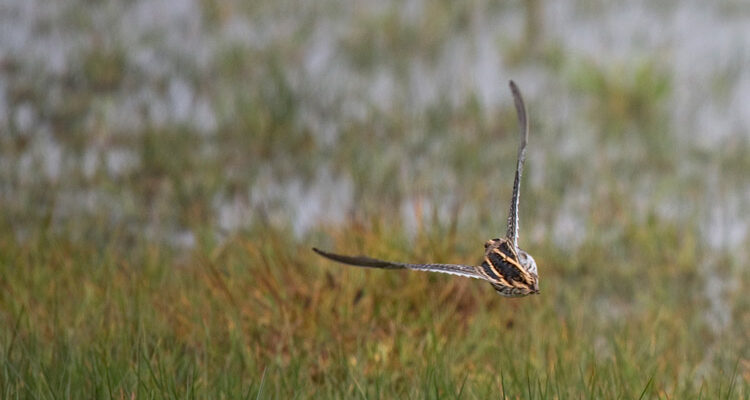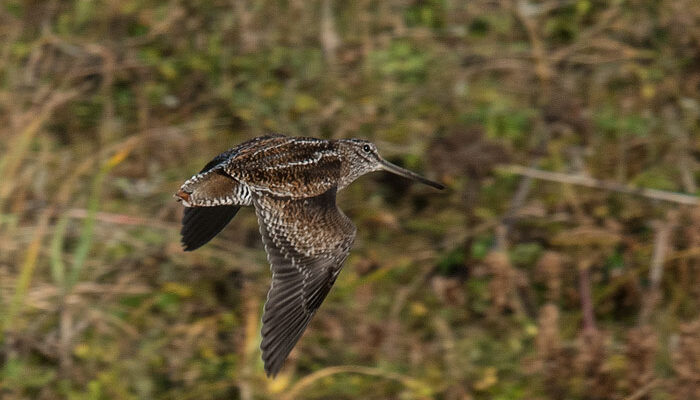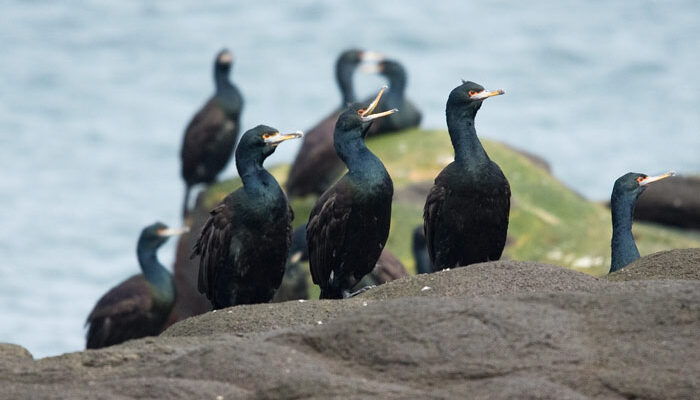The highlight of our 2018 fall tour St. Paul Island was this stunning Solitary Snipe, only…

Our First Fall Tour to the Pribilof Islands
St. Paul Island has now established itself as THE place to look for Jack Snipe in North America . Photo Aaron Lang.
The islands of the Bering Sea are some of the most remote birding destinations on the continent, and just getting there can sometimes be considered a victory! Our first ever fall tour to the Pribilofs got off to a rocky start when first a mechanical issue, and then dense fog, delayed our flight from Anchorage to St. Paul Island for two days. When we did finally arrive on the island on September 27th, we were eager get out birding. We quickly made up for lost time by relocating a relatively cooperative JACK SNIPE in our first hour of birding. This bird was first found on the island about 10 days earlier. Later in the afternoon we found a second Jack Snipe in Tonki wetlands! This species is still an incredible rarity in North America, but St. Paul Island in the fall is undoubtedly the best time and place to be if you hope to find this rare shorebird. While celebrating our luck with the snipe, we received a call that other birders on the island had found an OLIVE-BACKED PIPIT on the northeast end of the island. After dinner we joined with others and were able to relocate this bird, as well as a SKY LARK! By this time the winds had picked up considerably and made viewing both of these birds quite difficult. All were able to see the pipit in flight, and a few got looks on the ground, but generally the tough viewing conditions were a bit frustrating.
Highlights of our second day on the island included another look of the long-staying Jack Snipe, two Sky Larks, which were much more cooperative than the previous day’s bird, and a late evening foray for a BRAMBLING and a GYRFALCON that another group had found. While looking for the Brambling we kicked up a RED-BREASTED NUTHATCH, actually one of the rarest birds we saw on the island. “Rare” is of course a matter of perspective and during migration and “vagrant season” rarities can come from either direction, making birding the Bering Sea islands so much fun.
By day three we had thus far been unsuccessful connecting with the poster child for the Pribilofs—the Red-legged Kittiwake. While it’s a common and conspicuous nesting bird on the island, during late September they’ve left their cliffs for the open ocean. Red-legged Kittiwakes become pelagic more quickly then Black-legged Kittiwakes and their numbers near the island dwindle as September rolls along. A few, however, can still be seen coming into bathe and roost with the much more numerous Black-legged Kittiwakes on a couple of lakes on the island. But despite putting in considerable effort to find one, we were still shut out by late afternoon on our third day. So today’s efforts were split evenly between looking for migrants and vagrants and looking for the Red-legged Kittiwake. Success with the rarities came first, and came in a big way. We happened to be in the right place at the right time when a DUSKY THRUSH flew past our van and gave us a long flight look before disappearing into the dunes near Webster Lake! We got the word out and other birders arrived on the scene to look for the bird…and they came with news. They just had two RED-LEGGED KITTIWAKES in the flock on Big Lake, only a short drive away. So finally just before dinner on our third day on the island we got great views of this very special bird of the Pribilof Islands.
On our last morning on the island we were greeted by calm winds for the first time of the trip. The winds had blown 25-30 mph out of the west all night and we were hopeful that our last day would produce something else from the west. About 45 minutes into our morning a small brown passerine landed on shoulder of the road in front of our van. We worked hard to nail this bird down, but it proved to be a worthy adversary. After a some effort trying to follow this very shy and elusive skulker through the grass along Big Lake we all got decent flight views of the plain brown bird with the evocative name—SIBERIAN RUBYTHROAT!
Our shortened trip was actually one of the most rarity-dense four days of birding that I’ve ever had on the island, or anywhere in North America! This was a great trip, with a great group of people, and a number of incredible rarities for such a short tour! The only disappointment of the tour was the difficulty that we had with shy and stealthy birds in strong winds, and that several of the rare birds that we found were very difficult view of and some were not seen by everyone.
Information on our next fall trip to the Pribilofs can be found here.
~Aaron Lang

